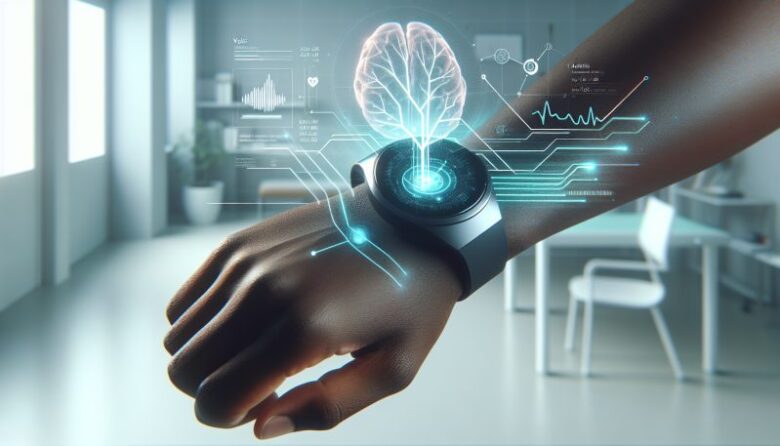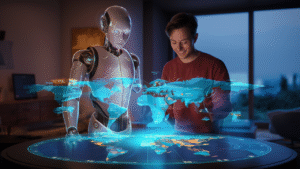Improved machine learning algorithms, greater access to data, and cheaper hardware are driving AI adoption in healthcare settings. AI can sift through vast quantities of data – patient records, medical research, and genetic information—much faster than humans can. AI can use supervised learning to identify patterns in images and data in order to complete tasks such as reading text or recognizing objects, while generative AI allows content creators to make new material based on existing patterns.
1. Predictive Analytics
Predictive analytics is a descriptive statistical technique that utilizes existing data to make predictions of future events. Applications range from weather forecasting, video game creation, and voice-to-text translation to customer service strategies as well as investment portfolio strategies (1-5). AI-powered predictive analytics are revolutionizing healthcare by customizing treatment plans based on each patient’s individual traits and genetic makeup. Predictive models also help identify high-risk individuals so that preventive care can be offered early on to avoid hospital admissions and improve overall health outcomes.
AI-powered predictive analytics is also revolutionizing how insurance companies assess coverage risk and set premiums, with this technology used to detect fraud, expedite claim reimbursement processes, and ultimately cut operational costs across the industry.
2. Automated Scheduling
AI tools offer efficient and accurate tools for booking appointments, reservations, and service bookings, helping reduce delays while assuring all clients are completely satisfied. Generative AI can analyze patient data, such as medical history and lifestyle choices, to generate personalized educational materials for improving health outcomes. Furthermore, this AI solution can assist with interpreting lab test results and suggesting treatment options.
Generic AI models are capable of handling everything from transcription of meetings and emails to email organization, data analysis, and marketing copywriting. But for optimal use, it’s vital that organizations use only reliable gen AI models while taking steps to prevent bias by being transparent about selection, usage, and governance structures for these technologies.
3. Patient Adherence
AI can bring many advantages, from increasing surgical precision and automating scheduling and paperwork reduction to data analytics, which detect potential fraudsters. But AI’s most promising application may lie in improving patient adherence.
One of the biggest barriers to adherence is patients not understanding their medications. Physicians should avoid blame or shame tactics and instead encourage patients to share their beliefs and barriers related to taking their medicine in an open and non-judgmental setting. Generative AI can assist with this by creating personalized adherence education materials based on patient data and needs; however, it’s crucial that initial data be chosen carefully when training generative models to avoid any biases or introduce any biases into them.
4. Artificial Intelligence Chatbots
AI-powered chatbots are artificially intelligent programs created to interact with humans through natural language simulation. Their vast knowledge bases allow them to provide answers and automate tasks such as customer service, reviewing medical paperwork, or scheduling appointments.
Your employees learn and evolve over time as a result of interactions with customers. This reduces workload so they can concentrate on more complex cases. However, depending on technology could cause additional access issues for some patients. For instance, chatbots require users to access them via a text-based interface and reliable internet connectivity in order to function.
5. AI-Powered Robots
AI robots are used across industries. From retail stores and restaurants to farm fields and industrial settings. AI robots greet customers in stores, wait tables in restaurants, harvest ripe vegetables from farm fields, and perform complex tasks such as cutting, grinding, welding, and inspection tasks.
Utilizing onboard or edge computing, sensors, and machine learning/deep learning algorithms, AI robots collect data about their environments in order to analyze and respond accordingly. They even utilize natural language processing (NLP) technology in order to communicate with humans directly in real time, reducing human error while increasing productivity and increasing productivity levels. AI robots have even assisted surgeons during precise surgical procedures like hip and knee replacement surgeries.
6. Artificial Intelligence in the Emergency Room
Triage is an essential aspect of emergency medicine, and AI has demonstrated considerable promise here. By shortening waiting times and freeing nurses up for more pressing cases, triage AI offers invaluable help in emergency care settings.
The study employed an artificial intelligence (AI) algorithm to help triage patients across three emergency rooms (ERs). This system outshone human triage nurses, ranking patients more accurately by severity at registration. This study’s limitations include its inability to capture nurses’ individual acumen, which could explain why certain nurses outperformed AI. Also, AI’s opaqueness makes it hard for healthcare professionals to comprehend its decisions.
7. Artificial Intelligence in the Operating Room
AI technology has revolutionized healthcare, empowering hospitals and clinics to increase efficiency while improving patient outcomes. For example, software developed by Olive allows healthcare institutions to automate medical billing procedures, reducing errors while cutting administrative overhead costs.
Operating rooms now frequently employ AI algorithms as a second set of eyes during surgery, monitoring vital signs and anesthesia levels to reduce surgical errors such as leaving surgical sponges inside patients’ bodies or performing incorrect procedures. These AI systems serve as the “second pair of eyes.” AI can also help reduce both time and costs involved with drug development, for instance by employing machine learning for screening data to select candidates for clinical trials.
8. Artificial Intelligence in the Pharmacy
AI in pharmacy is revolutionizing drug discovery, drug formulation, patient care monitoring, and more. For successful integration of these tools, however, medical instruction needs to include them, creating safeguarded machine learning methods as well as addressing concerns over data quality and privacy as well as gradually adopting AI that complements rather than replaces human skills.
AI can reduce documentation time for physicians, freeing their energy up to focus on providing patients with top-quality care. AI also improves dispensing accuracy while saving pharmacists the manual effort involved with filling medication orders.
9. Artificial Intelligence in the Home
Generative AI differs from traditional smart home voice assistants by producing responses based on user input. This type of AI has been applied to tasks such as document scrubbing, information extraction, and action initiation. Generative AI can also be leveraged to automate tasks and increase productivity. For instance, an intelligent voice assistant that learns that its owner prefers jazz music upon awakening can automatically play this genre when they wake up.
AI brings intelligent home systems a step further by understanding user patterns and providing personalized experiences – for instance, a smart thermostat could adjust itself while someone is away to reduce energy use and save money.




